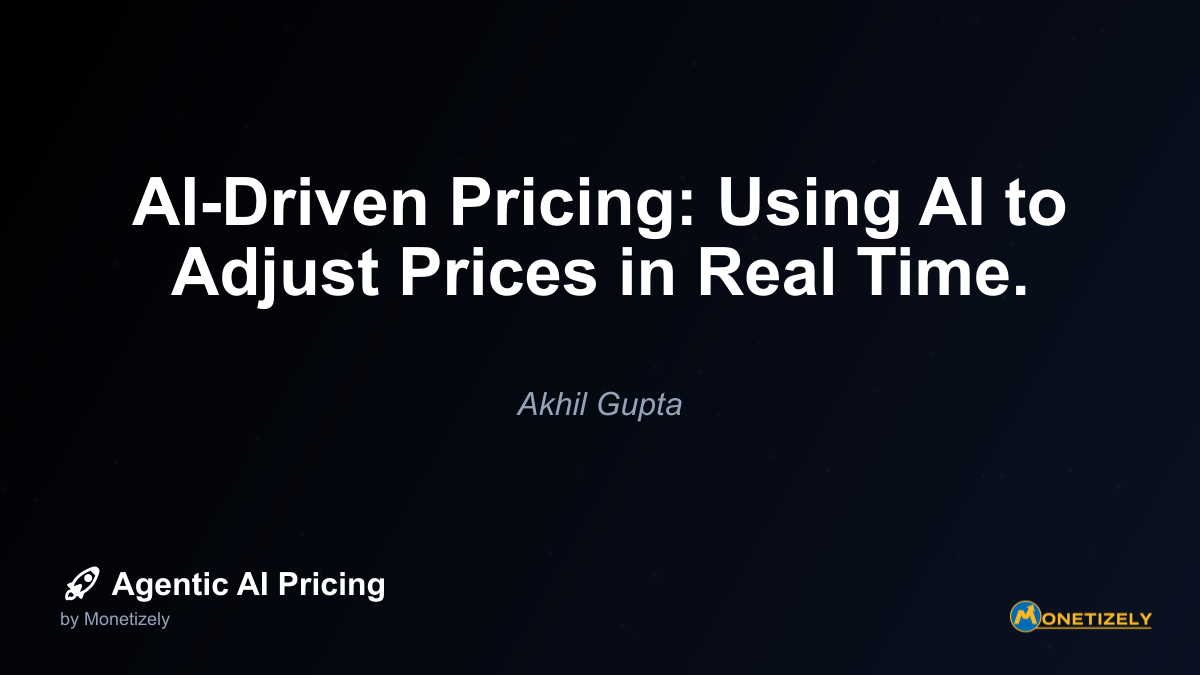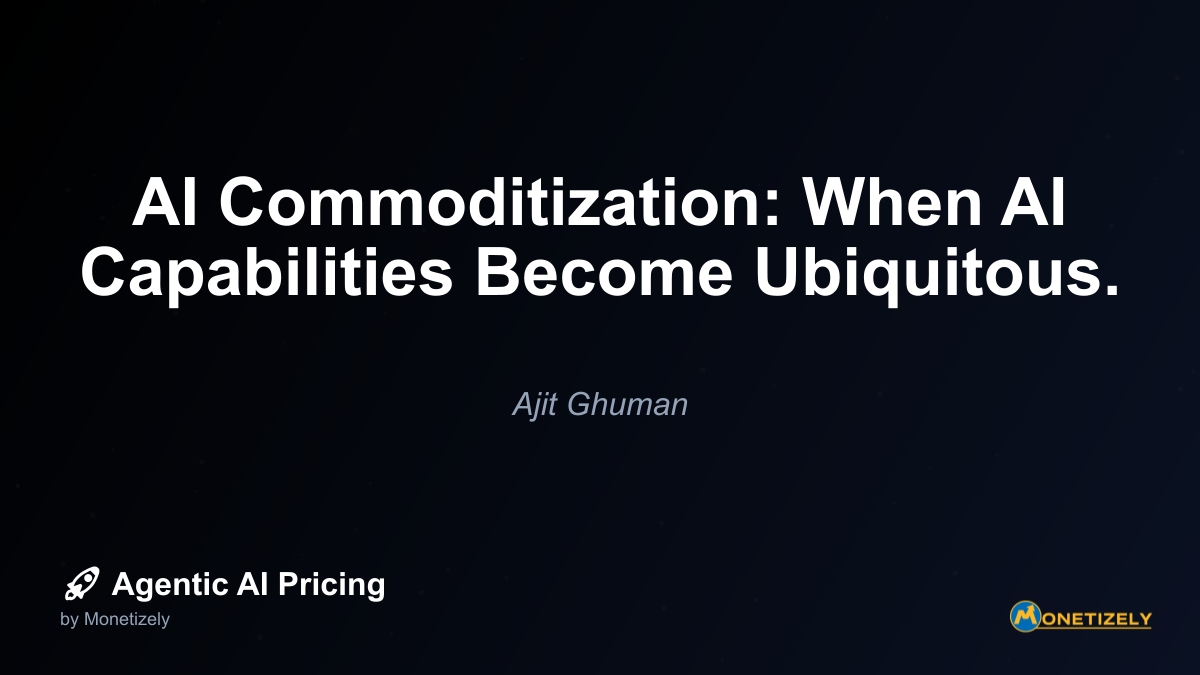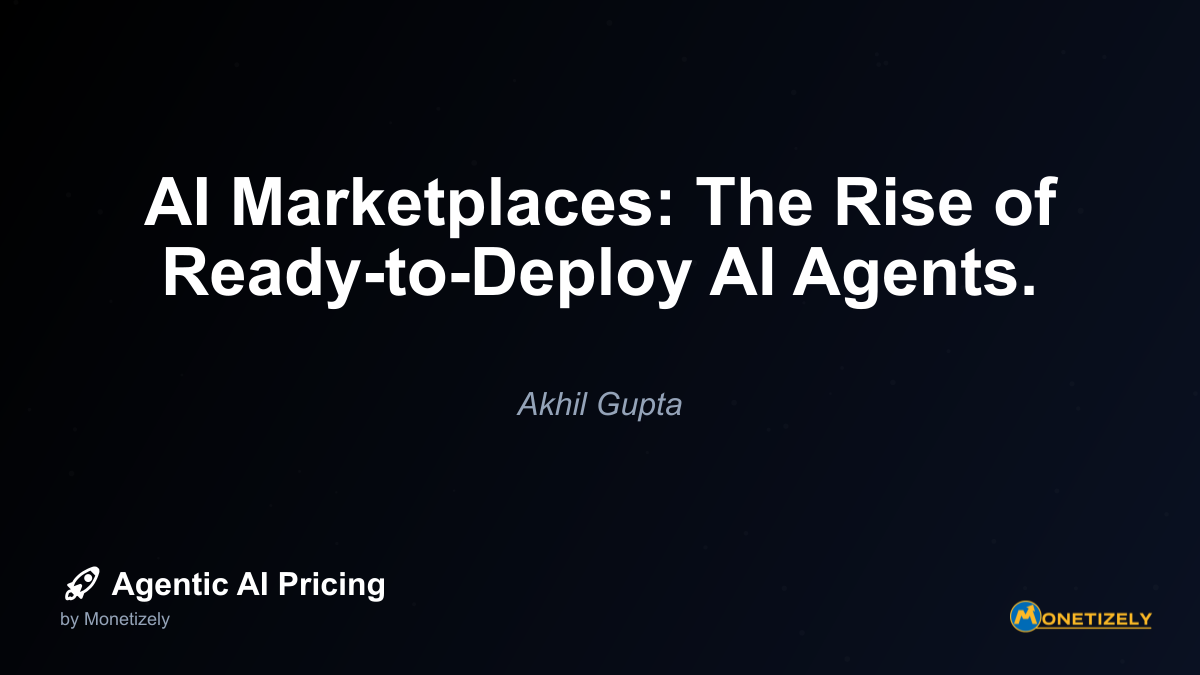· Akhil Gupta · Emerging Trends · 8 min read
AI-Driven Pricing: Using AI to Adjust Prices in Real Time.
AI and SaaS Pricing Masterclass
Learn the art of strategic pricing directly from industry experts. Our comprehensive course provides frameworks and methodologies for optimizing your pricing strategy in the evolving AI landscape. Earn a professional certification that can be imported directly to your LinkedIn profile.

In today’s rapidly evolving digital economy, businesses face unprecedented challenges in pricing their products and services optimally. Traditional static pricing models are increasingly giving way to sophisticated, data-driven approaches that can respond to market conditions in real time. At the forefront of this revolution is artificial intelligence, which is transforming how companies determine and adjust their pricing strategies.
AI-driven pricing represents a paradigm shift in how businesses approach one of their most critical decisions. By leveraging machine learning algorithms and vast datasets, companies can now implement dynamic pricing models that continuously optimize revenue, market share, and customer satisfaction simultaneously.
The Evolution of Pricing Strategies
Pricing has evolved dramatically over the decades. What began as simple cost-plus models eventually gave way to value-based pricing, competitive pricing, and segmented pricing strategies. Each evolution brought increased sophistication and better business outcomes, but all shared a common limitation: they required manual adjustment and oversight.
The introduction of rule-based dynamic pricing in industries like airlines and hospitality represented the first step toward automation. These systems could adjust prices based on predefined conditions like inventory levels, time until service delivery, or competitor prices. However, they still relied on human-created rules and couldn’t truly learn or adapt independently.
AI-driven pricing represents the next evolutionary leap. These systems don’t just follow rules—they create and refine them autonomously, continuously learning from market responses to optimize pricing decisions across countless variables simultaneously.
How AI-Driven Pricing Works
At its core, AI-driven pricing utilizes machine learning algorithms to analyze vast amounts of data and make pricing decisions that maximize predefined business objectives. These systems typically incorporate several key components:
Data Collection and Integration
The foundation of any AI pricing system is comprehensive data. This includes:
- Historical pricing data and corresponding sales volumes
- Customer behavior and segmentation information
- Competitor pricing and positioning
- Market conditions and external factors
- Product costs and margin requirements
- Inventory levels and supply chain constraints
Modern AI pricing platforms integrate with CRM systems, ERP platforms, web analytics, and external market data sources to create a holistic view of the pricing environment.
Advanced Analytics and Machine Learning
Once data is collected, AI systems employ sophisticated analytical techniques to identify patterns and relationships:
- Regression analysis to understand price elasticity across different segments
- Classification algorithms to categorize customers by price sensitivity
- Time series analysis to identify seasonal patterns and trends
- Reinforcement learning to optimize pricing strategies over time
- Natural language processing to analyze customer sentiment and feedback
These techniques allow the system to understand complex relationships between pricing decisions and business outcomes that would be impossible for humans to discern manually.
Real-Time Adjustment Capabilities
The most powerful AI pricing systems operate in real time, continuously monitoring conditions and making adjustments as needed:
- API integrations with e-commerce platforms and point-of-sale systems
- Automated deployment of price changes across channels
- Real-time competitive price monitoring
- Continuous feedback loops to measure effectiveness
- Guardrails and approval workflows for significant changes
This real-time capability allows businesses to respond instantly to changing market conditions, competitor actions, or shifts in demand patterns.
AI Pricing in Different Industries
While the fundamental principles remain consistent, AI-driven pricing manifests differently across industries:
E-commerce and Retail
In retail, AI pricing systems analyze competitor prices, inventory levels, and customer behavior to optimize pricing across thousands or even millions of SKUs simultaneously. Amazon famously changes prices millions of times per day using AI algorithms, with some products seeing multiple price changes within a single hour.
These systems can identify cross-price elasticities (how price changes on one product affect demand for others) and optimize entire category pricing strategies rather than just individual products.
SaaS and Subscription Businesses
For subscription businesses, AI pricing focuses on optimizing customer lifetime value rather than single transactions. These systems analyze usage patterns, feature adoption, and churn indicators to identify the optimal pricing structure for different customer segments.
AI can also identify when customers are ready for upsells or at risk of downgrading, enabling proactive pricing adjustments to maximize retention and expansion revenue.
AI Services and API Pricing
Perhaps most intriguingly, AI services themselves are increasingly using AI to price their own offerings. Companies providing machine learning APIs, for instance, can analyze usage patterns, computational costs, and customer value to dynamically adjust pricing tiers and usage-based rates.
This creates a fascinating scenario where AI is essentially determining its own value in the market—a meta-application that highlights the technology’s transformative potential.
Benefits of AI-Driven Pricing
Organizations implementing AI-driven pricing strategies typically report several significant benefits:
Revenue and Profit Optimization
The most immediate impact is typically financial. McKinsey research suggests that AI-driven pricing can increase margins by 2-5% for most businesses, with some seeing improvements of up to 10%. This occurs through:
- Capturing more value from less price-sensitive customers
- Identifying underpriced products or services
- Reducing unnecessary discounting
- Optimizing promotional timing and depth
For a business with $100 million in revenue and 30% gross margins, even a 2% improvement represents $2 million in additional profit—a substantial return on investment.
Enhanced Competitive Responsiveness
AI pricing systems can monitor competitor actions and respond appropriately without overreacting:
- Matching price decreases on highly visible or elastic products
- Maintaining premium pricing where brand value supports it
- Identifying opportunities when competitors increase prices
- Predicting competitive moves based on historical patterns
This balanced approach prevents destructive price wars while ensuring the business remains competitive where it matters most.
Improved Customer Experience
Contrary to popular belief, dynamic pricing doesn’t necessarily mean charging the highest possible price. Well-designed AI pricing systems can actually enhance customer experience by:
- Offering personalized pricing based on individual value perception
- Providing timely discounts to incentivize desired behaviors
- Ensuring consistent pricing across channels
- Creating transparent and logical pricing structures
When implemented thoughtfully, AI pricing can align prices more closely with the actual value customers receive, improving satisfaction and loyalty.
Implementation Challenges and Considerations
Despite its potential benefits, implementing AI-driven pricing comes with significant challenges:
Data Quality and Availability
AI systems are only as good as the data they consume. Organizations often struggle with:
- Fragmented data across multiple systems
- Inconsistent historical pricing information
- Limited visibility into competitor pricing
- Insufficient transaction volume for certain products
Successful implementation requires a comprehensive data strategy that addresses these gaps before or alongside AI pricing deployment.
Organizational Readiness
Pricing decisions touch nearly every aspect of a business, making organizational alignment crucial:
- Sales teams may resist perceived loss of pricing authority
- Finance departments may worry about margin predictability
- Marketing teams may have concerns about brand positioning
- IT departments must support integration requirements
Change management is often the most challenging aspect of AI pricing implementation, requiring executive sponsorship and cross-functional collaboration.
Ethical and Regulatory Considerations
AI-driven pricing raises important ethical questions that organizations must address:
- Transparency about how prices are determined
- Potential for algorithmic bias or discrimination
- Privacy concerns related to personalized pricing
- Regulatory compliance across different jurisdictions
Leading organizations establish clear ethical guidelines and governance frameworks to ensure their AI pricing practices align with their values and legal requirements.
Best Practices for Implementation
Organizations that successfully implement AI-driven pricing typically follow several best practices:
Start with a Clear Strategy
Before selecting technology, define what you’re trying to achieve:
- Identify specific business objectives (revenue growth, margin improvement, market share)
- Determine which products or customer segments to prioritize
- Establish clear metrics for measuring success
- Set realistic timelines for implementation and value realization
This strategic foundation ensures technology serves business goals rather than driving them.
Adopt a Phased Approach
Rather than attempting a comprehensive implementation immediately, successful organizations typically:
- Begin with a limited product set or customer segment
- Implement basic capabilities before adding complexity
- Run parallel pricing processes during initial phases
- Gradually expand scope as confidence and capabilities grow
This approach builds organizational confidence while allowing for adjustments based on early learnings.
Invest in Human Expertise
Despite automation, human expertise remains essential:
- Data scientists to develop and refine algorithms
- Domain experts to provide business context and constraints
- Change management specialists to drive adoption
- Executive sponsors to align organizational incentives
The most successful AI pricing implementations combine technological sophistication with deep human expertise in both pricing and change management.
The Future of AI-Driven Pricing
As technology continues to evolve, several emerging trends will shape the future of AI pricing:
Increased Personalization
AI pricing will increasingly move beyond segmentation to true personalization, with:
- Individual-level price optimization based on willingness to pay
- Dynamic bundling tailored to specific customer needs
- Personalized promotion and discount strategies
- Contextual pricing based on usage scenarios
This evolution will require careful balancing of personalization benefits against potential concerns about fairness and transparency.
Enhanced Explainability
As AI pricing becomes more sophisticated, explaining pricing decisions will become increasingly important:
- AI systems that can articulate the rationale behind price recommendations
- Visual analytics that help humans understand complex pricing relationships
- Natural language explanations of pricing strategies for stakeholders
- Audit trails that document pricing decision factors
These capabilities will help build trust and facilitate collaboration between human pricing experts and AI systems.
Ecosystem Integration
Future AI pricing systems will extend beyond organizational boundaries:
- Integration with supplier pricing and cost structures
- Collaborative pricing optimization across value chains
- API-driven pricing ecosystems that span multiple businesses
- Industry-specific pricing networks and benchmarks
This ecosystem approach will unlock new opportunities for value creation while requiring new approaches to data sharing and collaboration.
Conclusion
AI-driven pricing represents one of the most powerful applications of artificial intelligence in business today. By enabling real-time optimization across countless variables, these systems help organizations maximize value creation while responding dynamically to changing market conditions.
However, successful implementation requires more than just advanced technology. Organizations must address data challenges, align stakeholders across functions, and establish appropriate governance frameworks to ensure their AI pricing practices are both effective and ethical.
For businesses willing to make this investment, the rewards can be substantial: increased profitability, enhanced competitive positioning, and improved customer relationships. As AI technology continues to evolve, those who master these capabilities early will gain significant advantages in increasingly dynamic markets.
The future of pricing isn’t just dynamic—it’s intelligent, adaptive, and increasingly autonomous. For business leaders across industries, understanding and harnessing this potential has become a critical strategic imperative.
Co-Founder & COO
Akhil is an Engineering leader with over 16+ years of experience in building, managing and scaling web-scale, high throughput enterprise applications and teams. He has worked with and led technology teams at FabAlley, BuildSupply and Healthians. He is a graduate from Delhi College of Engineering and UC Berkeley certified CTO.
Pricing Strategy Audit
Let our experts analyze your current pricing strategy and identify opportunities for improvement. Our data-driven assessment will help you unlock untapped revenue potential and optimize your AI pricing approach.




